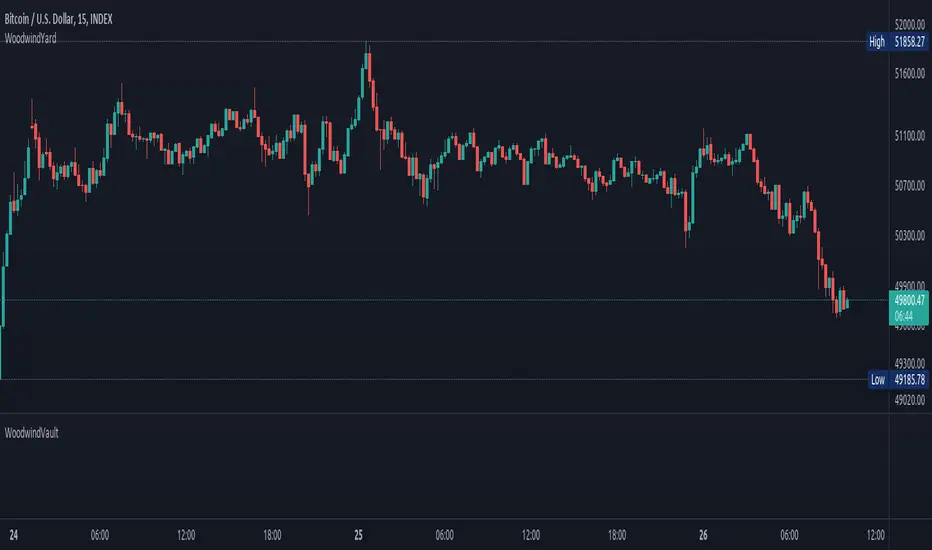PINE LIBRARY
מעודכן Woodwind Vault

Library "WoodwindVault"
Woodwind Vault provides reusable functions to support Thange Woodwind Playbook execution.
getHighestHighAndLowestLow(period) determines the highest-high and lowest-low for the specified time interval.
Parameters:
period: int, the time interval for finding the highest-high and lowest-low.
Returns: float, the highest-high and lowest-low of the candles in the specified period.
findEquilibrium() projects a one glance view of the entire resistance net faced by the price. It does so by computing different equilibrium points for the price.
Returns: longTermEquilibriumB float, the midpoint of highest-high and lowest-low of the candles in last longTermPeriod.
getGlance(fast, slow) glances over the 2 equilibrium points from moving averages and establishes whether its bullish or bearish.
Parameters:
fast: float, the fast moving point.
slow: float, the slow moving point.
Returns: string, it is "bullish" if fast moving point is over the slow moving point o/w returns "bearish".
positionRelativeToLevel(point, level) determines first point's position w.r.t a specified level.
Parameters:
point: float, the first point (typically a fast moving average).
level: float, the second point acting as a level (typically a slow moving average).
Returns: string, the above/below/at position w.r.t level.
positionRelativeToRange(point, fromLevel, toLevel) determines first point's position w.r.t a range (typically a resistance band).
Parameters:
point: float, the first point.
fromLevel: float, the from-range which is typically a fast moving line.
toLevel: float, the to-range which is typically a slow moving line.
Returns: string, the above/below/within range.
Woodwind Vault provides reusable functions to support Thange Woodwind Playbook execution.
getHighestHighAndLowestLow(period) determines the highest-high and lowest-low for the specified time interval.
Parameters:
period: int, the time interval for finding the highest-high and lowest-low.
Returns: float, the highest-high and lowest-low of the candles in the specified period.
findEquilibrium() projects a one glance view of the entire resistance net faced by the price. It does so by computing different equilibrium points for the price.
Returns: longTermEquilibriumB float, the midpoint of highest-high and lowest-low of the candles in last longTermPeriod.
getGlance(fast, slow) glances over the 2 equilibrium points from moving averages and establishes whether its bullish or bearish.
Parameters:
fast: float, the fast moving point.
slow: float, the slow moving point.
Returns: string, it is "bullish" if fast moving point is over the slow moving point o/w returns "bearish".
positionRelativeToLevel(point, level) determines first point's position w.r.t a specified level.
Parameters:
point: float, the first point (typically a fast moving average).
level: float, the second point acting as a level (typically a slow moving average).
Returns: string, the above/below/at position w.r.t level.
positionRelativeToRange(point, fromLevel, toLevel) determines first point's position w.r.t a range (typically a resistance band).
Parameters:
point: float, the first point.
fromLevel: float, the from-range which is typically a fast moving line.
toLevel: float, the to-range which is typically a slow moving line.
Returns: string, the above/below/within range.
הערות שחרור
v2הערות שחרור
v3Added:
getEquilibriumPeriods(scheme) gets a suitable combination of equilibrium periods for the specified scheme.
Parameters:
scheme: string, the name of the scheme.
Returns: 4 float values, a best suited combination of equilibrium periods.
computeExitGains(entry, exit, qty, remainingQty, direction) calculates the gains after a position is scaled down.
Parameters:
entry: float, the entry price of the short/long position.
exit: float, the exit price of the short/long position.
qty: float, the quantity by which a position is to be scaled down.
remainingQty: float, the remaining quantity before the scale down.
direction: int, its -1 for a short position and +1 for a long position.
Returns: _gains float, the profit & loss after the scale down.
Updated:
positionRelativeToRange(point, fromLevel, toLevel) determines the placement of price w.r.t a range (i.e. a dynamic resistance band).
Parameters:
point: float, the price.
fromLevel: float, the from-range which is typically a fast moving line.
toLevel: float, the to-range which is typically a slow moving line.
Returns: string, the above/below/within range.
הערות שחרור
v4Removed:
getHighestHighAndLowestLow(period) determines the highest-high and the lowest-low value for the specified interval.
getEquilibriumPeriods(scheme) gets a suitable combination of equilibrium periods for the specified scheme.
findEquilibrium() projects a one glance view of the entire resistance net faced by the price. It does so by computing different equilibrium points for the price.
getGlance(fast, slow) glances over the 2 equilibrium points from moving averages and establishes whether its bullish or bearish.
positionRelativeToLevel(point, level) determines the placement of price w.r.t the specified resistance/support level.
positionRelativeToRange(point, fromLevel, toLevel) determines the placement of price w.r.t a range (i.e. a dynamic resistance band).
ספריית Pine
ברוח האמיתית של TradingView, המחבר לפרסם את הקוד של Pine הזה כספרייה בקוד פתוח, כך שמתכנתים אחרים בקהילתנו יעשו שימוש חוזר. כל הכבוד למחבר! ניתן להשתמש בספרייה הזו באופן פרטי או בומים בקוד פתוח, אך השימוש בחוזר בקוד הזה בפרסומים כפוף ל-כללי הבית.
כתב ויתור
המידע והפרסומים אינם מיועדים להיות, ואינם מהווים, ייעוץ או המלצה פיננסית, השקעתית, מסחרית או מכל סוג אחר המסופקת או מאושרת על ידי TradingView. קרא עוד ב־תנאי השימוש.
ספריית Pine
ברוח האמיתית של TradingView, המחבר לפרסם את הקוד של Pine הזה כספרייה בקוד פתוח, כך שמתכנתים אחרים בקהילתנו יעשו שימוש חוזר. כל הכבוד למחבר! ניתן להשתמש בספרייה הזו באופן פרטי או בומים בקוד פתוח, אך השימוש בחוזר בקוד הזה בפרסומים כפוף ל-כללי הבית.
כתב ויתור
המידע והפרסומים אינם מיועדים להיות, ואינם מהווים, ייעוץ או המלצה פיננסית, השקעתית, מסחרית או מכל סוג אחר המסופקת או מאושרת על ידי TradingView. קרא עוד ב־תנאי השימוש.